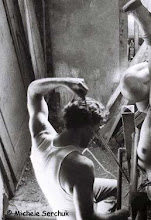Exerpted from a much longer essay concerning problems of art-making. Because bondage is a convenient foil for my aesthetic explorations, it's often convenient for me to post bits of my perambulations here to see what sticks. I wish I could say that they will be in some sort of order (as though this time were any different form any other), but like the thoughts underlying them they are more likely to partial, discontinuous and maybe a bit scattered. I find working ideas out in a semi-public forum to be a tonic to the process, and when the time comes that all these fragments gain a sense of cohesion, readers of whatever monograph emerges then will be as appreciative of your patience as I am now, maybe even more so.
I lift the text straight out of MS Word, so the diacritics, footnoting, and other formatting elements translate only half well to this blog editor, but at least the information is complete. Again, apologies.
Critical comments are, as always, welcome.
***
Rope bondage in the Japanese style is popularly thought of by its practitioners in Japan and elsewhere as an art form, but as such it is practically unknown by the artworld, meaning bondage has never been defined or validated by some agency appointed the task of positioning creative cultural artifacts. People who “do rope” often go by unusual titles (such as nawashi, dorei etc.) intended to confer some manner of special virtue in the creation of the living tableaus that characterize the forms and practice, and which appear (in the West at least) to imply the existence of a dedicated and objective critical cadre charged with assigning such titles. In Zen Buddhist Japan, entitlement is franchised within the iemoto system, a traditional way of controlling access to intellectual information and cultural endowment.1 Entitlement designating skill with rope is something that can neither be claimed nor striven for; the term nawashi (or kinbakushi, or whatever the latest terminal designation may be) is like a one-word Zen koan, its meaning a product of intuition rather than reason.
I use the term living tableaus above because a case is sometimes made for bondage referring to the tying of inanimate objects (e.g., Barbie dolls, boutique display windows, etc.). I will be limiting my appreciation of bondage in this essay as signifying rope applied to sentient persons, specifically consenting adult sentient persons. Whether or not such adults themselves are doing the describing, Japanese bondage scenes employ a unique vocabulary to describe their forms and elements, and while these appear to be largely and uncritically accepted by rope connoisseurs in practice, thoughtful observers allow that most of the jargon is precisely that, jargon, being often of dubious provenance or etymology, in either Japanese or other languages. This aesthetic obscurantism not only advances the material interests of the iemoto but preserves the mystique of Japanese bondage, imbuing it with an ineffable quality that should be properly viewed as consistent with Zen predicates and teleology, and desirable in and of itself.
Shibari has become the de facto term denoting rope restraint in the Japanese style. Interestingly, according to well-informed sources working in Japan, erotic and artistic application of rope to a body for purposes of restraint goes as often by the English "bondage" as by shibari (or any of its variations).2 The naming issue gets loopier still when we look at the etymology of the English "bondage". In its erotic (and as well for our present purpose, artistic) calibration bondage is a popular appropriation of a term referring to ‘serfdom’ or ‘slavery’ according to Webster’s Unabridged Dictionary. Only very lately has it come to be associated with sadomasochistic technique, specifically physical restraint. Etymologically the word is closer at its root to duty or obligation, rather than anything having to do with art or eroticism. Thus does Somerset Maugham’s Of Human Bondage have more to do with social restraint than the other kind (although problems of art-making are the leit motif of that book, and at the thematic core of the author's The Moon and Sixpence. Maugham had a thing for the Siamese-twinning of beauty and restraint). While many of the foremost Japanese exponents of shibari use the term liberally, it has only sketchy currency in Japan, and then perhaps as mostly a marketing hook by which to attract westerners keen to believe that their fancy has a bit of the exotic about it.3 There are no qualified critical corps, organized schools of thought nor a collecting public by which one might objectively measure one’s advance to the rank of nawashi. As in the case of other aspects of the ancient iemoto system, it’s enough that an owner of the title grant it to another to give it meaning.
1 Leonard Koren summarizes the iemoto concept beautifully and concisely in his Wabi-Sabi for Artists, Designers, Poets and Philosophers (Stonebridge, Berkeley, 1994): “Primary text sources, artifacts and other materials needed for scholarly research are often controlled by iemoto families who, as in Zen Buddhism, insist that such essential information be shared only with those of their choosing... a vital part of iemoto proprietary intellectual property was not to be elucidated – given away – unless in exchange for money of favors.”
2In the 1974 Masaru Konuma film Wife to be Sacrificed , screenwriter Yôzô Tanaka has the eponymous wife (Tani Naomi) utter “shibatte” in begging her lover to tie her up. Shibari is an appropriated noun form of the verb shibaru (see www.asanawa.com).
3Midori, a Japanese-American lecturer and presenter on bondage theory and technique, has suggested that the mania among western rope bondage connoisseurs for Japanese rope bondage is similar to the Orientalism of the Victorian era with its fascination for the ‘otherness’ of eastern cultures.

Subscribe to:
Post Comments (Atom)



















No comments:
Post a Comment